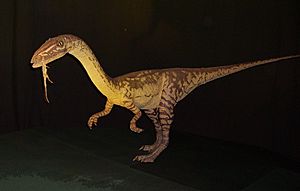Upper Triassic facts for kids
The Upper Triassic was the final part of the Triassic period. It started about 237 million years ago and ended around 201.3 million years ago. This epoch came after the Middle Triassic and before the Lower Jurassic.
The Triassic Period had two other epochs: the Lower Triassic and the Middle Triassic.
Contents
What Animals Lived in the Upper Triassic?
Many early dinosaur species first appeared during the Upper Triassic. These included dinosaurs like Plateosaurus, Coelophysis, and Eoraptor.
In the skies, Pterosaurs were common, flying around. In the oceans, Ichthyosaurs were the main predators.
What Caused the End of the Upper Triassic?
At the end of the Upper Triassic, a big event or series of events caused many animal species around the world to die out. This is known as the end–Triassic extinction event. It was similar to the more famous event that led to the extinction of the dinosaurs. However, scientists are not completely sure what caused the end-Triassic event.
There are several ideas about what might have caused it. Some theories suggest a meteorite impact, huge tsunamis, or even powerful bursts of energy from the sun called coronal mass ejections.
The Carnian Pluvial Event
The Triassic Period was generally a dry time, with many inland areas being deserts. However, the Upper Triassic epoch saw a big change in climate.
What Was the Carnian Pluvial Event?
The Carnian Pluvial Event (CPE) was a major global climate change that happened early in the Upper Triassic, about 230 million years ago. It also caused many species to die out.
Scientists have found changes in carbon and oxygen isotopes in rocks from this time. These changes suggest that the Earth experienced a period of global warming.
How Did the Carnian Pluvial Event Affect Life?
The CPE led to big changes for organisms that create calcium carbonate, which is used to build shells and skeletons. For example, in deep ocean areas of Southern Italy, the formation of carbonate rocks stopped.
Many ammonoids, conodonts, bryozoa, and crinoids died out during this event. After the CPE, new types of life appeared. This included the first dinosaurs, tiny marine fossils called calcareous nannofossils, and stony corals.
See also
 In Spanish: Triásico Superior para niños
In Spanish: Triásico Superior para niños


